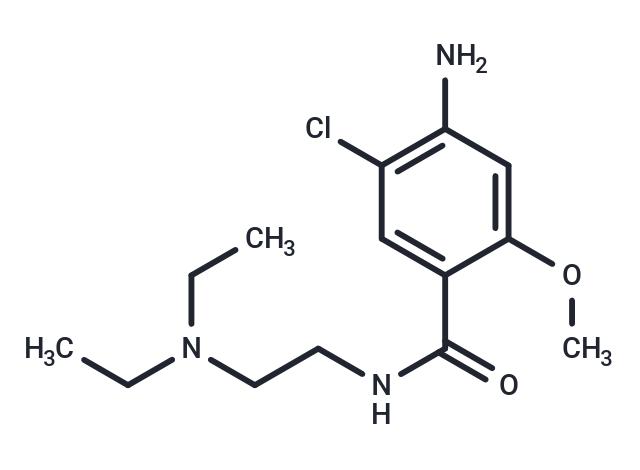- Remove All
 Your shopping cart is currently empty
Your shopping cart is currently empty
Metoclopramide
Metoclopramide (5-Chloro-2-methoxyprocainamide) is a dopamine D2 antagonist which has been used for treatment of a variety of gastrointestinal symptoms over the last thirty years. In various countries, metoclopramide is the antiemetic drug of choice in pregnant women. Findings provide reassurance regarding the safety of metoclopramide for the fetus when the drug is given to women to relieve nausea and vomiting during pregnancy. Evidence also supports its use for gastroparesis (poor stomach emptying) and gastroesophageal reflux disease. It appears to bind to dopamine D2 receptors where it is a receptor antagonist, and is also a mixed 5-HT3 receptor antagonist/ 5-HT4 receptor agonist.

Metoclopramide
| Pack Size | Price | Availability | Quantity |
|---|---|---|---|
| 50 mg | $40 | In Stock | |
| 100 mg | $55 | In Stock | |
| 500 mg | $125 | In Stock | |
| 1 mL x 10 mM (in DMSO) | $39 | In Stock |
Product Introduction
| Description | Metoclopramide (5-Chloro-2-methoxyprocainamide) is a dopamine D2 antagonist which has been used for treatment of a variety of gastrointestinal symptoms over the last thirty years. In various countries, metoclopramide is the antiemetic drug of choice in pregnant women. Findings provide reassurance regarding the safety of metoclopramide for the fetus when the drug is given to women to relieve nausea and vomiting during pregnancy. Evidence also supports its use for gastroparesis (poor stomach emptying) and gastroesophageal reflux disease. It appears to bind to dopamine D2 receptors where it is a receptor antagonist, and is also a mixed 5-HT3 receptor antagonist/ 5-HT4 receptor agonist. |
| Targets&IC50 | D2 receptor:483 nM (IC50), 5-HT3 receptor:308 nM (IC50) |
| Alias | 5-Chloro-2-methoxyprocainamide |
| Molecular Weight | 299.8 |
| Formula | C14H22ClN3O2 |
| Cas No. | 364-62-5 |
| Smiles | CCN(CC)CCNC(=O)C1=CC(Cl)=C(N)C=C1OC |
| Relative Density. | 1.2432 g/cm3 (Estimated) |
| Storage | Powder: -20°C for 3 years | In solvent: -80°C for 1 year | Shipping with blue ice. | |||||||||||||||||||||||||||||||||||
| Solubility Information | DMSO: 55 mg/mL (183.46 mM) | |||||||||||||||||||||||||||||||||||
Solution Preparation Table | ||||||||||||||||||||||||||||||||||||
DMSO
| ||||||||||||||||||||||||||||||||||||
Calculator
In Vivo Formulation Calculator (Clear solution)
Dose Conversion
Tech Support
Keywords

Copyright © 2015-2024 TargetMol Chemicals Inc. All Rights Reserved.



